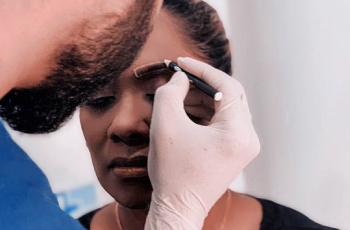






With thousands of treatments done yearly throughout the DHI global network, one of the crucial areas that has received attention is eyebrow restoration. Our eyebrows are a key feature of our face, playing an important part in expressing our expressions. Now, with the advanced DHI technique of hair restoration, you can cover up a scar or grow fuller-looking brows.
Thanks to the patented DHI Implanter, we are able to place each follicle on your eyebrows with controlled angle and depth, leaving no scars or stitches. The implanted hairs will then continue to grow with you throughout your lifetime, elevating your style and identity.
An eyebrow transplant is a surgical technique that moves hair follicles from the back of the scalp (donor area) to your eyebrows (recipient area).
The first step of an eyebrow transplant is to design the eyebrows together with you, taking into account every detail and characteristics of the face. Implanted hair follicles develop and behave as well as the rest of the eyebrows, giving you 100% natural results.
Hair follicles are transplanted with precision and care, ensuring natural results that look and feel great.
The DHI hair transplant ensures a min. of 97% follicle survival rate, leaving you with maximised results that will last a lifetime.
The minimally invasive DHI hair transplant requires only a short downtime after surgery – no pain, no stitches, no scars.
Medically approved and clinically tested, the DHI hair transplant is safe and uses advanced, patented tools.

By the DHI International Hair Restoration Academy, the one and only organised hair restoration academy in the world, which is regulated by strict DHI standards and protocols to ensure our patients receive the best results every time.

A careful and detailed examination of the scalp is done to determine the number of hairs available to donate. Our DHI Hair Specialists will then design a full masculine beard in line with your expectations.

Hair follicles are manually extracted one by one from the donor area using sharp, titanium-coated punches with diameter of 0.75 – 1.1 mm, leaving no scars.

Hair follicles are implanted directly using the patented DHI Implanter in a one-step process which ensures the right angle, direction and depth at the same time, ensuring 100% natural results.

All steps in the DHI Facial Hair Transplant are designed to guarantee you a min. of 97% hair follicle survival rate, leaving you with maximised results that will last a lifetime.
DHI |
FUE |
||
| Certified medical specialists perform the entire procedure | |||
| Medical assistants are not permitted to perform the procedure | |||
| Extraction process | Manual extraction of follicles by specialists using titanium-coated punches | Use of motorized extractors which generate heat and damage follicles. | |
| Implantation process | No slits or holes are made prior to implantation. Each follicle is inserted directly with the DHI patented implanter in a one-step motion. | Slits or holes are created in the recipient aera prior to implantation. Hair follicles are then placed in the slits using forceps in a two-step procedure. | |
| No scalp incisions prior to implantation | |||
| NO Scalpels, NO stitches, NO scars | |||
| Precise control of angle, direction and depth of implantation | |||
| No direct handling of hair follicles | |||
| Graft survival rate | 97% and more | 50% – 70% | |
| Maximum possible density | |||
| Natural looking results |
The staff at DHI Bahrain was very kind and helpful. They got to the root of my hair loss before recommending the right treatment for my condition. Thanks DHI!!
I had my hair transplant done and it does not feel itchy compared to my previous hair transplant experience from another clinic. I am very thankful to the DHI team for the great treatment they gave.
Amazed by the great service I’ve got at DHI Bahrain. The team was very professional, took really good care of me, and was very kind throughout the process. Definitely recommending DHI Bahrain for anyone who has hair loss issues.
We are an international medical group that specialises in hair loss with over 50 years of experience and scientific research.
The most common reason for hair loss in men is androgenetic alopecia. Up to 80% of men worldwide will experience significant hair loss from this condition. It is hereditary and related to the male hormone, di-hydro-testosterone or DHT.
This type of hair loss is progressive and if you do not do anything to stop it, the hair loss will worsen with time until you lose most of your hair.
Stage 1: Minimal hair thinning around temples and forehead.
Stage 2: Increased hair thinning with a slightly receding hairline around the temples.
Stage 3: Further receding hairline which pulls backwards from the temples, giving it a “M” shape.
Stage 4: Receding M-shaped hairline + significant hair thinning at the crown area.
Stage 5: Early signs of the U-shaped hairline. Bald spots are getting bigger and the strip of hair between the crown and the hairline is much thinner than before.
Stage 6: U-shaped hairline with minimal hair left at the front and top of the head.
Stage 7: Top of the head is completely bald, left with thin strip of hairs at the side of the head.
Whether or not you’re a suitable candidate for a hair transplant depends on a few factors which can only be assessed by our DHI Hair Specialist during the consultation.
Factors that we need to consider include family history of hair loss, age, onset of hair loss, stage of hair loss, availability of donor hair, existing medical conditions and results of any prior or ongoing medical interventions.
In cases where you are a good fit for hair transplant, the next step would be to take a blood test to rule out any other form of deficiency that may be contraindicated for the procedure.
Implanted hairs will go through a shedding phase from the 1st month up to the 4th month post-procedure. New hairs will then grow from the 4th month onwards, with 80% of the result being observed during the 9th month mark. Maximum density will be reached after 12 months.
If you are looking for a quick fix, a hair transplant might not be for you. But if you’re looking to grow a full head of natural hair, we are here to help.
The number of follicles needed vary from patient to patient, depending on the stage of hair loss, size of the area to be corrected as well as the desired density.
You may need anything between 1,000 – 5,000 hairs in total and our DHI Hair Specialist will only be able to determine this after assessing your scalp and hair so that we can provide you with a personalised treatment plan that matches your expectations.
The cost of a DHI Hair Transplant is depending on the total number of hairs you require for your desired result. On average, the price per hair is RM7-10 but we do have special promotions in the clinic.
Our DHI Hair Specialist will need to determine your stage of hair loss first before we can propose a personalised treatment plan for you as we believe proper diagnosis is key.
We offer easy payment plans as well.
Before the procedure takes place, patients will receive a local anaesthetic, and you may feel a slight pricking sensation (like the tip of a pen on the scalp). Soon afterwards the anaesthetic numbs the skin, relieving any sensation throughout the procedure.
In terms of recovery, patients may experience mild discomfort, itching or redness for a few days afterwards. However, these are generally mild enough that patients are able to return to work within a day or two, at most.





